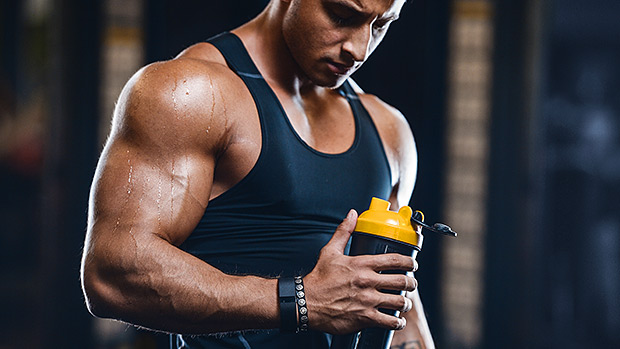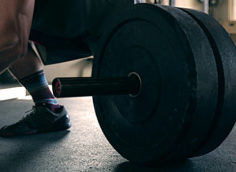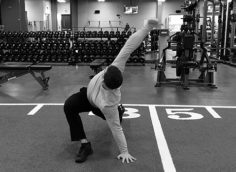Bodyweight training is a lost art. Decades ago, it was a staple of a lifter's training. You couldn't have a complete program without push-ups, pull-ups, dips, gymnastic-based movements, and isometrics.
But as time passed, we stopped viewing bodyweight training the same way. It lost its appeal... maybe because most lifters think it's too simple, easy, or predictable.
And that's a shame. Controlling your bodyweight through space is another piece of the puzzle in helping you live your healthiest life possible. Besides, if you can't lift and move your own body, how strong are you really?
Here's how to add new challenges and variety to your bodyweight training:
Let's say you usually do a normal set of ten push-ups. Now do those same ten reps, but lower yourself down for five seconds, hold the bottom for five seconds, then return back up for five seconds. That's just ONE pec-popping rep!
Sure, many lifters already DO lengthen the lowering phase and isometric holds of their bodyweight movements, but few extend the time they spend in the concentric or lifting phase.
This helps increase time under tension and forces you to focus on executing the full range of the movement. You also get a killer mind-muscle connection, which might not have been accomplished by just going through the motions.
Examples
Push-Up
Do 3x5: 5 seconds down, 5 second pause, and 5 seconds up
Bodyweight Bulgarian Split Squat
Do 3x5 each leg: 5 seconds down, 5 second pause, and 5 seconds up
This will increase the challenge of basic bodyweight movements. You can do this in multiple ways including weighted vests, heavy backpacks, chains, bands, manual resistance, etc.
Once you can crank out several pull-ups with good form, don't stop progressing them. Keep track of your weighted five-rep max the same way you keep track of your bench max.
Examples
Weighted Chin-Up or Weighted Dip
Test with a quarter of your bodyweight, so if you weigh 200 pounds, add 50 pounds of weight onto your body.
You can do a whole workout going from one exercise to the next while wearing a heavy backpack. Load it up with as much weight as you like and get to work. This is a "flow" series of exercises which we'll get to in just a bit.
This type of challenge creates a sense of urgency and helps you focus. No stipulations, just accumulate the prescribed number of reps as quickly (and correctly) as possible. Then record how long it took and try to beat it next time.
Examples
- Barbell Push-Up: 100 reps as fast as possible. Record your time and work to beat it next week.
- Bodyweight Dip: 100 reps as fast as possible. Record your time and beat it next week.
Do as many rounds as possible (AMRAP) within a specific amount of time. Instead of aiming for a number of reps, you're aiming to complete as many rounds (of a series of exercises) before your time is up.
Example
Do as many rounds as possible within 10 minutes:
- A1. Bodyweight Squat: 10 reps
- A2. Burpee: 10 reps
- A3. Mountain Climber: 20 reps each leg
This is just an example. Don't like burpees? Don't do them. Replace any or all of these exercises with what you want.
Instead of aiming for a total number or reps, or doing a series of exercises within a time cap, you'd do one exercise continuously for a prescribed amount of time, then move on to the next.
Example
- A1. Hindu Push-Up: 30 seconds
- A2. Step-Through Lunge: 30 seconds
- A3. Lying Glute Bridge: 30 seconds
- A4. Speed Skater: 30 seconds
Repeat 2-3 more times, resting 60 seconds between sets.
It's a completely forgotten aspect of training.
Animal Exercise Examples
Backward Bear Crawl
Lateral Bear Crawl
Spiderman Crawl
Crab Walk
Monkey Jump
Bodyweight flows are a type of circuit training where you do movements in a back-to-back fashion – "flowing" from one to the next. They're excellent as warm-ups or cooldowns.
Examples
Bodyweight Flow One
- A1. Push-Up: 10 reps
- A2. Scap Push-Up: 10 reps
- A3. Mountain Climber: 10 reps each side
- A4. Push-Up Plank Hand to Elbow: 10 Reps
- A5. Hand Walkout: 10 Reps
Bodyweight Flow Two
- A1. Squat Plus Reverse Lunge: 10 reps
- A2. Single Leg RDL: 8 reps each leg
- A3. Groiner: 8 reps each leg
- A4. Roll Over to V-Stretch: 10 reps
These are giant continuous sets of movements where the reps will often ascend/descend throughout the series. You can accomplish a lot in a little bit of time.
You do the first exercise for the prescribed number of reps, then immediately move on to the next exercise for the prescribed number of reps. Ideally, there's no rest between exercises or rounds.
Example
For this one, the reps are set up in a pyramid-style: they ascend and then descend.
- A1. Plank Shoulder Tap: 3,5,5,3
- A2. Lying V-Up: 5,8,8,5
- A3. Russian Twist: 10,15,15,10
So you'd do three plank shoulder taps, five V-ups, then ten Russian twists before moving on to to the next round.
Neglecting aspects of training as simple as moving your own body will only hinder your progress. No one says you have to become a bodyweight guru, but adding a few of these variations will help you become a more physically competent, mobile, and healthy person.





